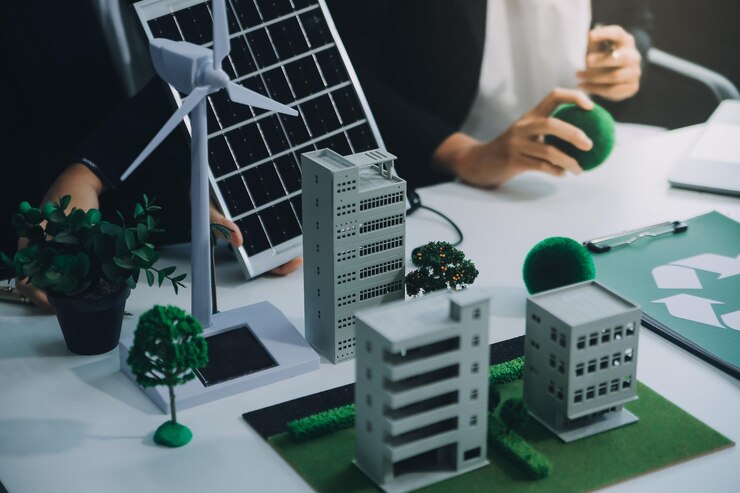In today’s rapidly evolving world, the construction industry is embracing more sustainable and eco-friendly practices. Green building energy solutions have become a central focus in reducing energy consumption, lowering carbon footprints, and creating energy-efficient, comfortable environments. These innovative solutions not only benefit the environment but also reduce long-term operational costs for building owners.
As the global demand for energy-efficient buildings grows, it’s important to understand how green building energy solutions can transform the way we design, construct, and operate buildings.
What Are Green Building Energy Solutions?
Green building energy solutions refer to a range of strategies, technologies, and practices used in the design, construction, and maintenance of buildings that focus on reducing energy consumption and enhancing sustainability. These solutions integrate energy-efficient materials, renewable energy systems, and smart technologies to create buildings that use less energy and have a minimal environmental impact.
The goal is to reduce reliance on non-renewable energy sources, lower greenhouse gas emissions, and ensure the long-term sustainability of the building. Whether it’s through the installation of solar panels, improved insulation, or intelligent lighting systems, green building energy solutions create a balanced approach that benefits both the environment and building occupants.
Key Components of Green Building Energy Solutions
1. Energy-Efficient Building Design
A well-thought-out building design is crucial for maximizing energy efficiency. This includes considerations such as building orientation, natural lighting, and passive cooling techniques. Energy-efficient buildings use architectural strategies that minimize heat gain in the summer and heat loss in the winter, reducing the need for excessive heating and cooling. These designs take full advantage of natural resources to maintain a comfortable indoor environment while using minimal energy.
2. Renewable Energy Systems
One of the most impactful green building energy solutions is the incorporation of renewable energy systems. Solar panels, wind turbines, and geothermal systems can supply power to buildings while reducing dependence on fossil fuels. Integrating solar power into building designs has become one of the most common and effective ways to generate clean energy. Not only does this reduce the building’s carbon footprint, but it also lowers energy costs for owners and tenants.
3. Energy Storage Solutions
To fully optimize the use of renewable energy, energy storage systems are becoming increasingly important. These systems store excess energy generated from solar panels or other renewable sources, which can be used during periods of high demand or when renewable generation is low. By integrating battery storage solutions into green buildings, energy consumption is more balanced, and building operations become even more sustainable.
4. Smart Building Technologies
Smart technologies are transforming the way we manage energy in buildings. With the advent of Internet of Things (IoT) devices and building automation systems, energy consumption can be monitored and controlled in real-time. Smart thermostats, motion sensor lighting, and automated HVAC systems allow building managers to adjust energy use based on occupancy, time of day, and other factors, further improving efficiency and comfort.
Why Are Green Building Energy Solutions Important?
1. Reduced Energy Costs
Implementing green building energy solutions can significantly reduce energy consumption, leading to lower utility bills. Energy-efficient buildings with smart technologies can track energy usage patterns, identify inefficiencies, and help optimize the use of resources. Over time, these cost savings add up, offering building owners a strong return on investment.
2. Environmental Impact
Buildings are responsible for a large portion of global energy consumption and carbon emissions. By adopting sustainable construction practices and integrating renewable energy solutions, buildings can dramatically reduce their environmental impact. The use of energy-efficient technologies, such as LED lighting and high-performance insulation, can help reduce a building’s carbon footprint and contribute to cleaner air and water.
3. Improved Comfort and Health
A well-designed green building not only reduces energy consumption but also improves the health and well-being of its occupants. Energy-efficient heating and cooling systems, along with superior air quality control, ensure a more comfortable and healthier indoor environment. By reducing pollutants and allergens and improving ventilation, these buildings create spaces that promote the well-being of those who live and work in them.
The Future of Green Building Energy Solutions
The future of green building energy solutions looks bright as more architects, builders, and policymakers recognize the importance of sustainable construction. As renewable energy technologies continue to advance and building materials become more energy-efficient, the possibilities for reducing energy consumption in buildings will only increase.
Building codes and standards will likely become stricter, demanding higher levels of energy efficiency and sustainability in new construction. The continued adoption of smart building technologies will enable even greater optimization of energy use, leading to buildings that are not only energy-efficient but also adaptable and resilient to future energy challenges.
Green building energy solutions are at the forefront of transforming the way we construct and maintain buildings. Through energy-efficient designs, renewable energy integration, and smart technologies, these solutions help create sustainable, eco-friendly buildings that benefit both the environment and the people who inhabit them. As the demand for sustainable construction grows, the development and implementation of green building energy solutions will play a crucial role in shaping the future of architecture, construction, and energy management.
By investing in these technologies today, we can reduce energy consumption, lower costs, and contribute to a healthier, greener planet for generations to come.




